The shift in the automotive landscape by merging of ECUs with diverse technologies

The Initial Age of ECU with Electric Vehicular Components
During the 1970s, the Automotive industry saw the introduction of radios and instrument clusters which were dubbed as ‘meters’ back then. Antennas to support their addition were also implemented, for drivers and passengers keen on seeking entertainment while on long drives. At that time, no one could have predicted the shifts in vehicular aspects such as design elements, ergonomics, and in-vehicle real estate that occurred over the next 50 years. This move was also a cherry-on-top for the passengers and drivers; and they didn’t complain about any reception or tuning issues. Automotive OEMs then started introducing features to ease the driving experience such as rotating headlamps, electronic power steering, automatic gearshifts, disk-type brakes, intermittent wipers, and power windows. The impact of mechatronics as an added advantage for pure-play mechanical system designs was clearly visible. OEMs and ECU manufacturers essentially monetized the benefits given to the customers. This covered not only services catering towards in-vehicle entertainment and overall ergonomics, but also safety features which were absent in the conventional purely mechanical vehicles. OEMs and research agencies started thinking in terms of too many operational parameters for the drivers to consider while driving. This paved the way towards automating select vehicular electromechanical switches and operational systems.
The dawn of the 21st century saw the adoption of GPS satellites and essential services, initially restricted for the military, towards wider commercial usage in vehicles. With this, various new organizations rose as module makers and mapping providers. Telecommunication organizations also started entering this space, providing the first generation of telematics in vehicles. At this point of time around 20 years ago, the organizations’ services focused only on location identification and the best routing options for vehicular navigation. ECU providers were using small, robust chipsets for specific embedded systems with limited processing, memory, and other sensory and control-based functionalities. These units were placed next to the point of actuation of mechanical devices, based on specific electromechanical sensor inputs within the vehicles’ real estate landscape. Nobody thought that these sensors and actuators would lead to formation of new organizations and businesses to help manage larger volumes in future. Antennas were also mounted with extensions, to leverage the maximum line of sight available for sending and receiving data via telecommunication and satellite infrastructure.
ECU Usage Pattern Shift during its Middle Age
The mix of hardware complexity and rise in ECU intelligence transformed mechanical designs into mechatronic alternatives with a powerful combination making vehicular systems robust, safe and secure. At the same time, electrical and electronic components within cars saw an exponential rise to support such ECUs. With the popularity of robust vehicles and the comfort they provided, the need for manufacturing such cars increased. Robotic assembly lines rose to the mantle with systems in place providing vehicle homologation along with the real estate landscape placements.
The rise in Advanced Driver Assistance Systems (ADAS) lead by cameras and ultrasonic sensors saw a spike in ECUs gaining more strength in terms of data, core, and memory pipelines. They enabled the sensors’ intelligence and provided prompt response to avoid and mitigate accidents. This was supported by telematics-based data to gain intelligence on the terrain being driven through and the necessary driving style required to maintain relative safe speeds. During their peak, ECUs, sensors, and actuators, had more than 200 units contributing to more than 200 million lines of code in a premium segment vehicle. This was like compressing the highly populated cities in the world within a car’s 1.9×4.7×1.7 meter3 real estate. The essential electronic, electrical, and mechanical components along with the sensors and actuators became densely populated. There was a need to free up space in the entire packaging and this began with the ECUs.
Current ECU Component Consolidation and Subsequent Complexities
In the last 4 years, several OEMs and Tier-1s realized that consumers including drivers and passengers appreciated ADAS and the additional safety, security, comfort and convenience provided by Autonomous, Connected and Electrification (ACE) technologies.
Connected cars not only provided infotainment and telematics applications as features, but also remotely updated themselves over-the-air. The mapping infrastructure was exposed to multiple low-earth-orbit satellites, and existing geostationary satellites, for consolidation enabling accurate positioning services. Maximum security was also provided for the telematics gateway to ensure only secure OTA updates were allowed within the vehicle. Consolidation of internal vehicle ECUs gained prominence in chips, with limited unauthorized access of critical vehicle infrastructure and actuators such as brakes and accelerations provided to the external telematics gateway. Exposure attacks for OTA updates were also a risk as seen with the Jeep Cherokee’s vulnerability providing unauthorized access to the braking infrastructure.
Connected cars also gained prominence for supporting ADAS and Autonomous Driving capabilities. Sensors and actuators were replicated to act as fail-safe modes as part of Functional Safety implementations. Along with sensors and actuators, ECUs also had a fail-safe support system to make it foolproof against crashes as much as possible. Some of these algorithms were partially transferred to remote servers or Cloud computers to satisfy the limited calculation possible within vehicle ECUs, domain controllers or zone controllers. V2X was another add-on gaining prominence both on the dedicated DSRC and on the C-V2X side, all of which increased complexity of the telematics gateway infrastructure. V2X provided beyond line-of-sight updates for maps, infrastructure and other critical road and vehicle density details. There were also multiple vulnerabilities being exposed, leading to strict vigilance of malware through Telematics Control Units. Massive data was throughput both in and out of the car; not only for entertainment but also for presenting critical infrastructure information in the telematics connections to the vehicle. Some amount of analytics was also being carried forward into the Cloud on such data.
The rise of electric vehicles and hybrids with the shift from conventional IC Engines led by government regulations and environmental groups resulted in necessary space reduction for the massive conventional engine. Depending on the model, some super-sport cars and buses had rear or front end engine configurations. However, at the same time the full electric motors were placed next to the wheels, with the batteries on the chassis spread and grouped. They had additional switch over components, inverters, and battery management systems to name a few. The boot space on certain normal vehicles freed space for massive driving recording and other units to come in place. Some also provided boot space in the front for smaller baggage. At the same time, the cooling required for the batteries increased airflow inlets, filters, and coolants to go down around the battery layouts. Further with COVID-19’s impact, OEMs are thinking of virus-resistant filters into the HVAC components as add-ons. Therefore, the filters and HVACs have additional components further increasing design complexities, along with those present in ECUs.
The Entry of Aggregation in Wireless Communications and Telematics Antennas
Around this time, another revolution was underway in the telematics ecosystem with massive wireless mediums all collaborating in the tiny vehicle real estate. The different wireless mediums in various domains like Bluetooth, WiFi, near-infrared, radar, ultrasonic, V2X (DSRC/C-V2X), LTE/5G, and GPS/GNSS were all aggregating inside the vehicle. The shark-fin antennas are also aggregating all possible combined wireless technologies into a single unit, adding to the accumulation of telematics antenna infrastructure.
The Automobile industry is constantly transforming itself by upscaling and providing the necessary comfort and convenience not only for high-end vehicles but also for medium and low-end segments. This ecosystem will play a crucial role in the revolution of smart cities that will run parallel to advancements in vehicle ecosystems.

Naresh Neelakantan is currently a Senior Architect for the Automotive Portfolio at Sasken Technologies Limited. With 15+ years of experience working with various Automotive companies, Naresh is enabling Sasken to navigate the next revolution in Automotive technologies. He is currently helping Sasken make strategic decisions in the areas of AUTOSAR and Autonomous Driving while aligning the Automotive ECU-to-DCU market with Sasken’s Chip-to-Cognition vision. He is an expert in Research & Technology Management of Embedded Software Architectures combining Analog sensors with Digital technologies and has successfully delivered more than 25 products (including microcontrollers, ECUs, BSPs, design models, architectures, and applications). They have been implemented for over 1 million on-road vehicles around the globe and he has also participated in more than 20 Model Year programs.
Published in Telematics Wire


